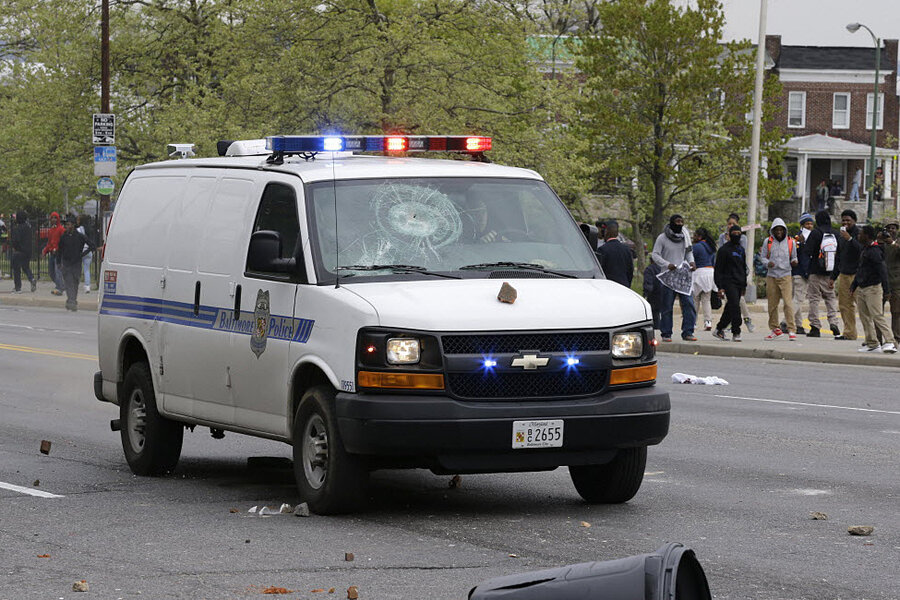Why Baltimore plans to add cameras inside police vans
Loading...
Police vans in Baltimore will soon be equipped with cameras to record and monitor what happens as prisoners are transported, Baltimore mayor Stephanie Rawlings-Blake said Wednesday, according to Reuters.
The measure was one of a series of reforms discussed during the riots this past April following the death of Freddie Gray, who sustained a fatal spinal injury while riding in a police van after being arrested. Six police officers have been charged with crimes relating to Gray's death, including second-degree murder. All have pleaded not guilty.
"We're working through a process that will place cameras with recording capabilities in the backs of all our police vans, to ensure that we have a more complete record of what occurs there," Rawlings-Blake told reporters.
The idea for van cameras comes on the heels of a national conversation about police body cameras. Body cameras, proponents have argued, would provide more transparency and deter police misconduct and complaints of misconduct.
Van cameras, in contrast, would shed light on the way people are treated once taken into custody. Mr. Gray, for example, was shackled at the hands and at the legs, and the officers neglected to buckle his seatbelt – a violation of policy that attorney Michael Davey, who represents one of the officers charged in Gray’s case, explained by claiming, “It is not always possible or safe for officers to enter the rear of those transport vans that are very small, and this one was very small.”
Similar incidents in police vans have not made many recent headlines, but there is a history. “Rough rides,” or “nickel rides” – a term likening the ride in a police van to “cheap amusement park thrills,” The Associated Press reported – drew scrutiny in a 2001 Philadelphia Inquirer investigation that examined 20 cases of victims who sustained injuries while riding in police vans.
Gino Thompson recalled in the report being taken into custody for “intoxication” on a night in 1994. The police van had “low,” “narrow” benches without seat belts, and hard walls. Mr. Thompson was handcuffed with his hands behind his back.
The cop driving accelerated – "like they were going to a fire or something," Thompson told the Inquirer – and all of a sudden, stopped short. Thompson lurched headfirst into a partition, and suffered damage to his spinal cord that left him paralyzed.
An Internal Affairs report on a similar case studied in the Inquirer report noted that a sudden stop or collision is likely to cause spinal damage when a person’s hands are cuffed behind his or her back, forcing the body into a position where the head is tilted slightly forward and becomes the point of impact.
The officer driving when Thompson was injured was put on three-day suspension, and got promoted to the rank of sergeant a year later. “That isn’t even a slap on the wrists,” Thompson told the Inquirer.
After the Inquirer investigation was released, the Philadelphia police department reportedly terminated “nickel rides,” but a 2013 follow-up suggested the practice had resumed.
In April, The Atlantic reported on “rough rides” in Baltimore, and cited three cases in which juries have sided with victims of injuries sustained in police vans who filed lawsuits against the police department, claiming their seat belts were left unbuckled and they were handcuffed.
“In 2004, a man named Jeffrey Alston won $39 million from Baltimore after he was paralyzed from the neck down during a police-van ride,” the report said. “The following year, Dondi Johnson Sr. won $7.4 million after a ride left him a paraplegic. In 2013, Johns Hopkins librarian Christine Abbott filed a suit against the department for a ‘rough ride’ after a 2012 arrest that resulted from a noise complaint.”
The practice of unsafe treatment of arrestees in police vans, the Atlantic reported, is unofficial but established enough that there are slang terms for various methods. “Bringing them up front” refers to stopping short so the prisoner is thrown forward. “Screen tests” involve the same concept, with the prisoner being flung into the screen partition between the front seat and the passenger area.
Rawlings-Blake did not say how long it would be before cameras are installed in all Baltimore police vans. According to Reuters, she added that there would also be a review of the gear police used during the April riots, some of which did not function properly, in preparation for potential unrest that could arise after the Gray case verdicts are reached.








